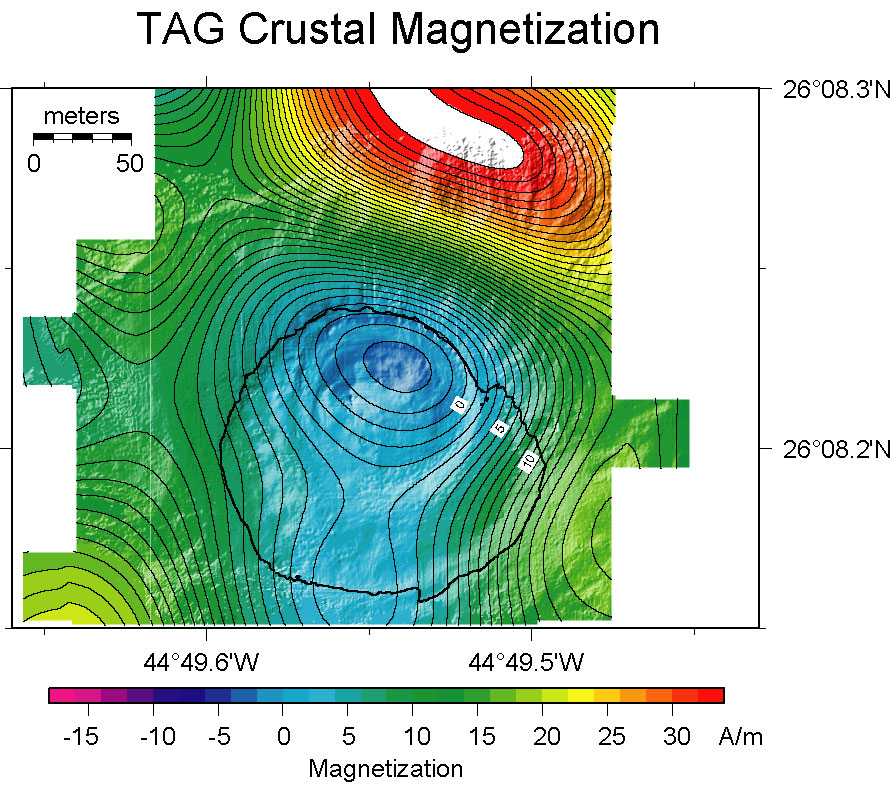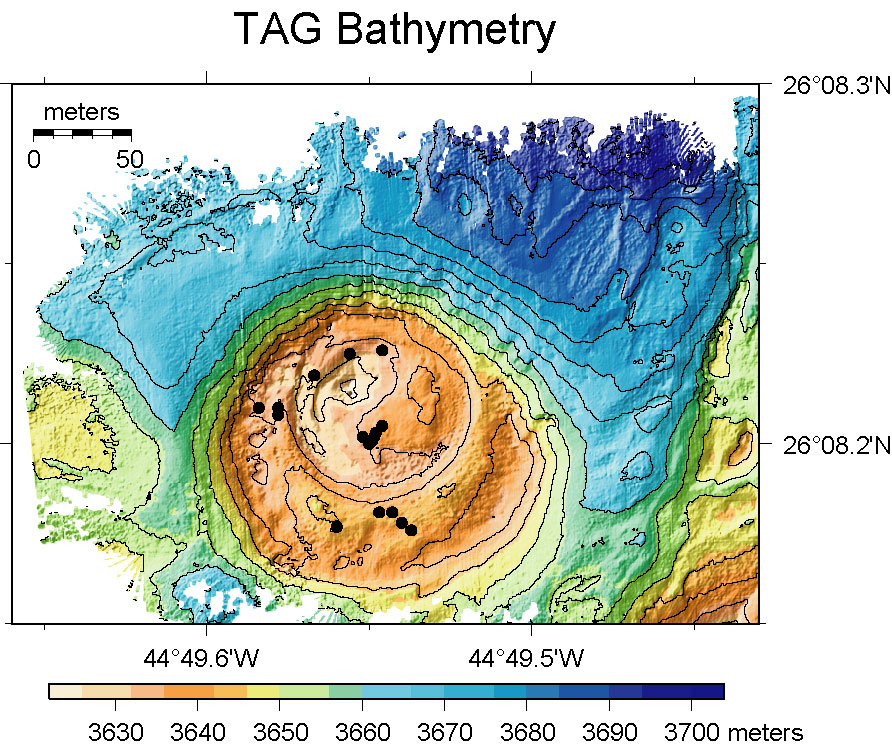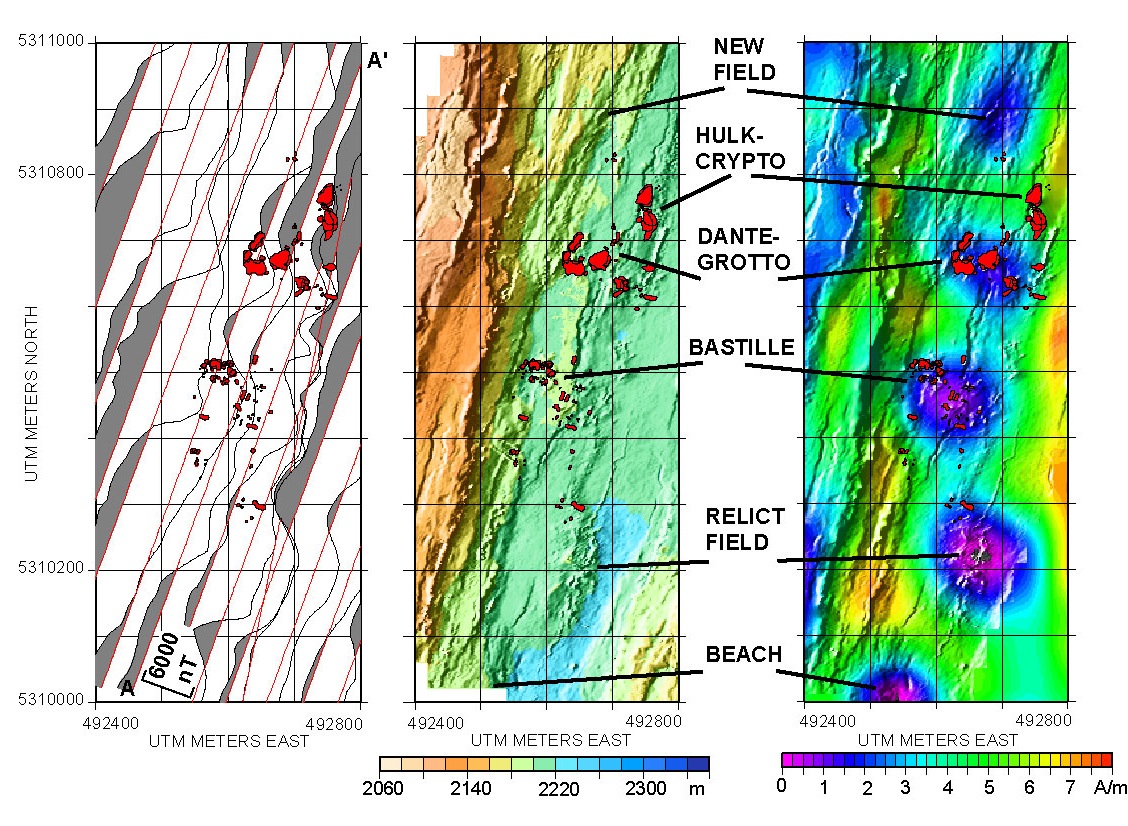Hydrothermal Magnetic Research
Deep sea hydrothermal vents can have a marked influence on the magnetism of the ocean crust. The magnetization of young oceanic crust arises primarily from the extrusive basaltic lavas that form the uppermost part of the seafloor. This magnetization is a primary thermal remanent magnetization carried by ferrous-rich titanomagnetite grains, which are highly sensitive to alteration. The highly acidic and corrosive fluids that flow through marine hydrothermal vent systems can quickly alter or replace the iron-rich magnetic minerals, reducing the magnetism (remanence) of the crustal rocks, in some cases to zero (Ade-Hall et al., 1971; Auerbach and Bleil, 1987; Johnson et al., 1982; Rona, 1978).
Following the discovery of hydrothermal vent systems in 1977, it wasn't until high-resolution near bottom geophysical mapping using deeptowed or near-bottom vehicles (submersibles, ROVs or autonomous underwater vehicles) in the early 1990's was it possible to collect data with sufficient spatial resolution to image the patterns of magnetization related to hydrothermal alteration. The first discovery of a "magnetic burnhole" was made using the submersible Alvin in a magnetic survey over the TAG mound (Tivey et al., 1993). Subsequent surveys at the Juan de Fuca ridge (Tivey and Johnson, 2002) and at other locations have since shown the ubiquitous occurrence of magnetic signatures related to vent deposits. To date magnetic imaging has been the only technique to rapidly survey and quantify the subsurface structure of vent systems. See list of publications below for more details.
Links to published papers on the magnetism of hydrothermal systems
- Tivey and Dyment, 2010: The magnetic signature of hydrothermal systems in slow spreading environments. AGU Monograph v. 188
- Tivey, Schouten and Kleinrock, 2003: A near-bottom magnetic survey of the Mid-Atlantic Ridge at 26°N: Implications for the tectonic evolution of the TAG segment. J. Geophys. Res.
- Tivey and Johnson, 2002: Crustal magnetization reveals subsurface structure of Juan de Fuca Ridge hydrothermal vent fields. Geology
- Tivey, Rona and Schouten, 1993: Reduced crustal magnetization beneath the active sulfide mound, TAG hydrothermal field, Mid-Atlantic Ridge at 26°N. Earth and Planet. Sci. Letts
- Tivey, 1989: High-resolution geophysical studies of oceanic hydrothermal systems. CRC Critical Reviews in Aquatic Sciences
Marine mining issues.
High resolution near-bottom magnetic surveys can be used to image the subsurface extent of demagnetized crust (i.e. altered crust) at vent sites, which by inference can be related to subsurface mineralization. Thus, the magnetic method can be used as a geophysical prospecting tool, as it is on land. The magnetic signature might be a useful tool to find, not only active systems, but also inactive, extinct, or even buried mineral deposits. Other geophysical techniques such as gravity mapping or electromagnetic sounding are capable of directly imaging mineralization, but those techniques are not yet fully developed for deep ocean use. The issue of deep sea mining is highly contentious but perhaps also, a coming reality, as the technology and economics become more favorable for development.
- Hoagland, Beaulieu, Tivey, Eggert, German, Glowka, Lin, 2010: Deep-sea mining of seafloor massive sulfides. Marine Policy


